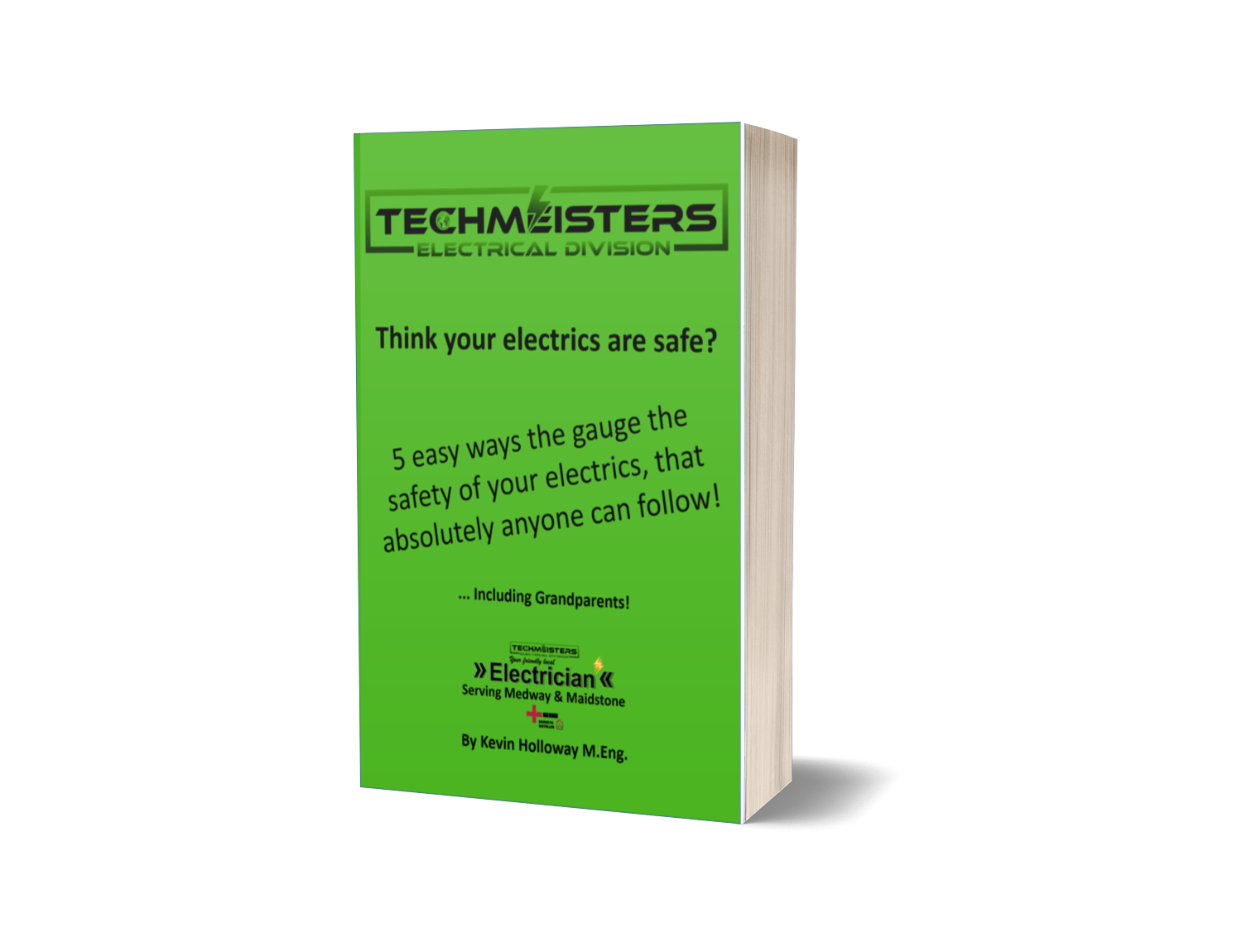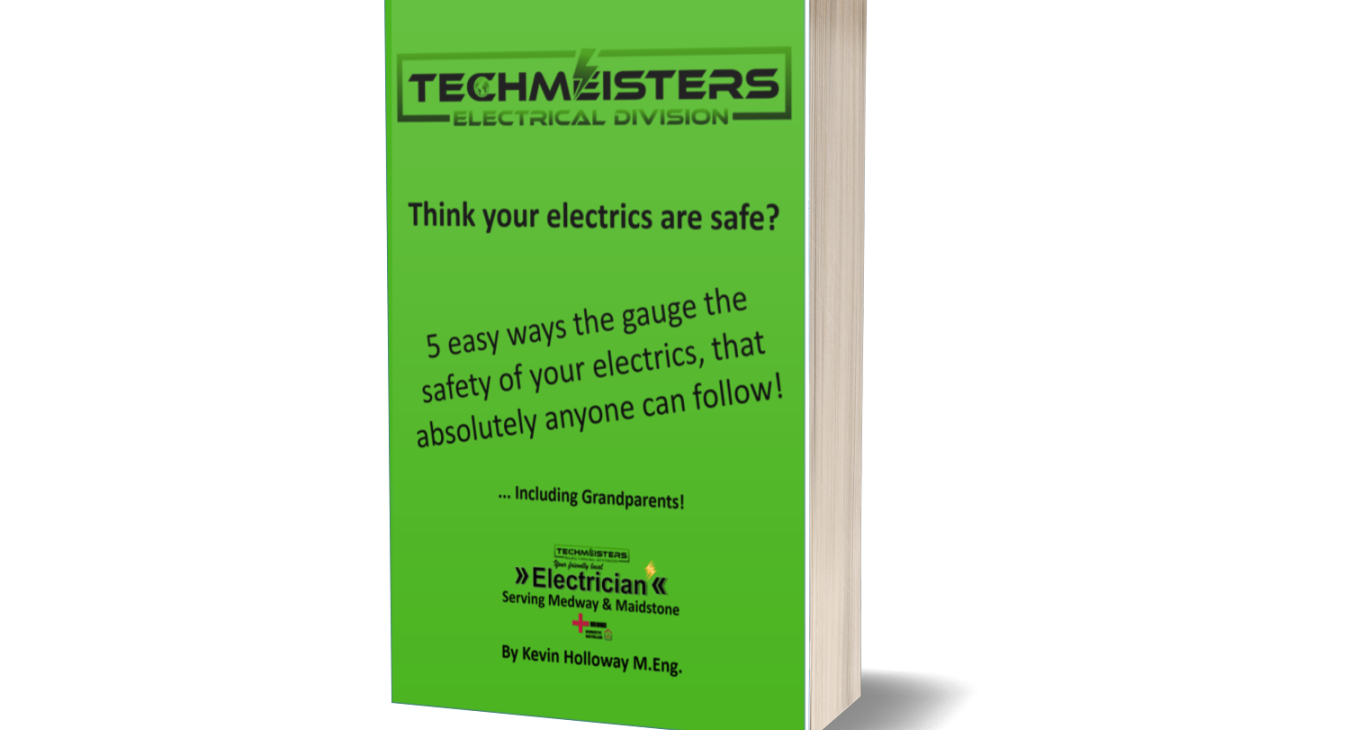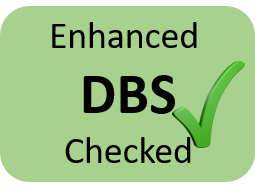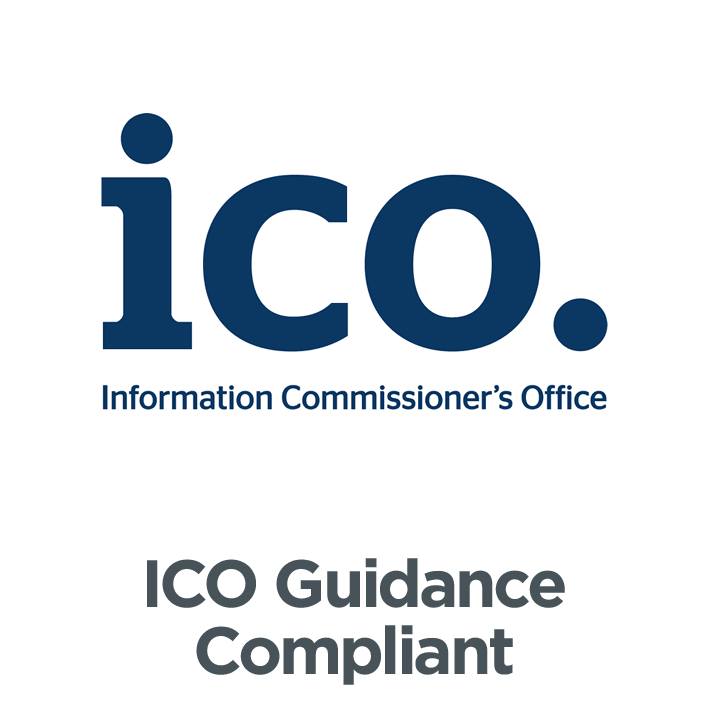What is an Electrical Installation Condition Report (EICR) and Why Do You Need One? (2023)
An electrical installation condition report (EICR) is a document that provides an assessment of the safety and condition of the electrical wiring and installations in a property. It is also known as an electrical safety certificate or a periodic inspection report, and more informally known as an electrical test, an electrical safety test or as we like to call it, "a health check on your electrics"!
An EICR is carried out by a qualified and competent electrician who inspects and tests the electrical circuits and equipment in accordance with the BS 7671:2018, also known as the 18th edition wiring regulations. The electrician will check for any defects, damages, deterioration, or potential hazards that could pose a risk of fire, electric shock, or injury to the occupants or visitors of the property.
Shall we get right into it?
Who might need an EICR?
EICRs For Landlords
As a landlord, it is your responsibility to ensure the electrical safety of your rental properties. An EICR inspection conducted every 5 years is a legal requirement for rented accommodation. An up-to-date EICR certificate proves you have fulfilled your duty of care to your tenants. It also protects you from potential prosecution and penalties.
EICRs For Buyers of property
If you are purchasing a property, asking the seller to provide a recent EICR report is strongly recommended. This will identify any urgent electrical faults that need fixing, and gives you peace of mind that the electrics are safe and compliant. Any issues flagged in the EICR can be used to negotiate on the sale price.
EICRs For Sellers of property
Having an up-to-date EICR certificate can help you sell your property faster and for a better price. Providing a recent report to potential buyers demonstrates you have maintained the electrics responsibly. Any faults needing urgent attention can be fixed before putting the property on the market.
EICRs For Grandparents
As grandparents, we want our grandchildren to visit us safely. Having an EICR inspection gives us confidence there are no electrical risks in our home. It also sets a good example, encouraging our children to be vigilant with electrical safety in their own homes. The small upfront investment is worth it for peace of mind.
Why should I have a thorough EICR carried out?
WAIT: Before you go any further, may we interest you in looking at nearly 100 of our juiciest (read: Worst looking) finds we have ever come across in our gallery dubbed "The Wall of Flame"?
That's exactly why you should have a thorough EICR done. Whilst an EICR is not a legal requirement for all properties, it is highly recommended for several reasons. Here are some of the benefits of getting an EICR:
Ensure Compliance with Legal Obligations
Depending on the type and use of the property, there may be different legal obligations that require an EICR to be carried out at regular intervals. For example:
- Landlords: As of June 1, 2020, landlords in England are required to obtain an EICR for every rental property they own before the start of a new tenancy and every five years thereafter. Landlords must also provide a copy of the EICR to their tenants within 28 days of the inspection. Failure to comply with these regulations could result in fines of up to £30,000.
- Homeowners: Homeowners who are planning to sell or buy a property may need to obtain an EICR as part of the conveyancing process. An EICR can provide assurance to potential buyers that the property is safe and compliant with the current standards. It can also help homeowners identify any issues that need to be fixed before putting their property on the market.
- Businesses: Businesses that operate from commercial premises are required to comply with the Electricity at Work Regulations 1989, which state that all electrical systems and equipment must be maintained in a safe condition. An EICR can help businesses demonstrate that they have taken reasonable steps to ensure the safety of their employees, customers, and visitors. The frequency of EICR for businesses may vary depending on the type and nature of the business, but it is generally recommended to have one every one to five years.
Save Money - A stitch in time saves nine!
Think of an EICR as a bit like an MOT for your properties electrics. Could you imagine taking your car for an MOT after 10 years of not having one? The rust that could have been an easy fix has turned into a gaping, flaking hole underneath your car seats. Oops! Another benefit of getting an EICR is you will be able to catch these issues sooner rather than later. An EICR can identify any faults and defects that might cause unnecessary costs in the future. For example, an EICR can detect:
- Overloaded circuits or sockets that could cause overheating, melting of cables, or tripping (emergency call out, anyone!)
- Loose or faulty connections that could cause sparks or fires
- Damaged or outdated wiring that could cause short circuits, tripping RCDs or power cuts
By fixing these issues, an EICR can help reduce the risk of electrical accidents and improve the reliability and lifespan of the electrical systems and equipment. This can also result in lower maintenance costs in the long run.
Protect Your Property and Peace of Mind With Reduced Risks
The most important benefit of getting an EICR is that it can protect your property and peace of mind from the dangers of faulty or unsafe electrical installations. According to Electrical Safety First, a leading charity dedicated to reducing deaths and injuries caused by electricity in the UK, there are around 20,000 house fires, 70 deaths, and 350,000 serious injuries caused by electricity each year. Many of these incidents could have been prevented by regular electrical inspection and testing.
An EICR can help you avoid these tragic consequences by identifying and rectifying any potential hazards before they cause harm. An EICR can also provide you with a clear and comprehensive record of the condition and compliance of your electrical installations, which can be useful for insurance purposes or legal disputes.
Landlords: What Happens if I Don't Have a Valid EICR?
As a landlord, not having a valid EICR certificate can lead to penalties and prosecution. Local authorities have the power to serve improvement notices and fines. For homeowners, lack of an EICR could make selling more difficult and create safety risks for you and your family. While not mandatory, regular electrical inspections are strongly advised for all properties, and are more and more often expected at the point of sale of a property.
How to Get an Electrical Installation Condition Report (EICR)
If you are interested in getting an EICR for your property, here are some steps you need to follow:
Find a Qualified and Competent Electrician (NICEIC Registered)
The first step is to find a qualified and competent electrician who can carry out an EICR for your property. You should look for an electrician who is registered with one of the government-approved schemes, such as NICEIC, NAPIT, or ELECSA. These schemes ensure that their members are trained, insured, and regularly assessed to meet the highest standards of safety and quality.
You Must ensure the electrical contractor you order to do the work allocates enough resources to be able to carry out the EICR adequately and effectively. For example, a simple 3 bed semi-detached house, with no garage power, shed power, and no extravagant electrical systems will generally take us half a day to test, perform some quick wins, and around another hour to compose the certificate and double check it in the office. A typical electrical test such as this costs in the region of £240, with any remedials on top. Sorry to break the news to anyone hoping a free EICR! We are not aware of a single electrical contractor in the UK who carries out electrical installation condition reports for free - even if the property doesn't pass the safety test!
Book an Appointment and Prepare Your Property
The next step is to book an appointment with the electrician and prepare your property for the inspection and testing. You should agree on a date and time that is convenient for both parties and confirm the cost and duration of the service. You should also make sure that the electrician has access to all the electrical installations and equipment in the property, including the fuse box, sockets, switches, lights, appliances, and any outdoor or hidden wiring.
This part is very important: Locate your water main stopcock and your gas meter. Your electrician will want to see if its adequately bonded (has an earth cable going to the pipework). The water main stopcock if often the hardest to find. It may be:
- Under your kitchen sink
- Behind a kitchen unit after a new kitchen refit
- If you have a w/c near the front door, it could be there, possibly boxed in
- It could be under the floorboards near the front door
We're specialists in conducting EICRs for our clients in Medway & Maidstone. We've got to a point in our EICR and remedial work that we've produced our very own free DIY EICR ebook. It's a very simple guide that anyone can follow, without even lifting a screwdriver. To help you better prepare your property for the EICR you might want to take a peek and familiarise yourself a little bit more about what we'll be looking at and what sort of defects we'll be looking for.

You should also inform the electrician of any known issues or concerns you have with your electrical installations, such as cracked soockets, yellowing and browning on any light switches and sockets, frequent tripping, flickering lights, burning smells, fishy burning smells, or exposed wires. This can help the electrician focus on the areas that need more attention and provide you with more accurate and relevant advice.
It is here where our "quick wins scheme" really comes out to play. We tell our clients to leave a PC sum to the side. £200 generally covers the little wins for most standard properties. We say to our clients if we can see an easy fix and we have the electrical installation pulled apart anyway, we may as well fix it there and then and just add it to the bill. If it helps the property pass first time, everyone wins. Having said that, not all properties pass an EICR the first time, and we may find compliance failures that require significantly more resources to fix, for which we'll have to quote separately, and likely will have to arrange the remedials to the non-compliances on a second visit.
What is checked on an EICR?
During an EICR inspection, the following aspects of the electrical installation are thoroughly examined:
- Consumer Units (Fuse Box)
The consumer unit is a critical component of any electrical system. The EICR assesses its condition, ensuring that it holds the correct safety devices, is properly installed, and free from defects. The electrician will to behead and shoulders in the fusebox so please ensure there is plenty of access. - Wiring and Circuits
All electrical wiring and circuits are checked for good workmanship, good connections (continuity), signs of wear, damage, or overloading. The inspection ensures that the wiring is in good condition and is safe enough for continued use. The wiring is inspected wherever possible: At the fuse box, at light fixtures, switches, sockets, and more. Our EICRs dictate that we won't use invasive or intrusive techniques in order to gain access (in simple terms, we wont rip cables out of the walls or have your carpets up and starting taking a crowbar to your floorboards, just to have a look). Good access to as many of this points as possible will reduce the likelihood of an EICR fail due to FI unsatisfactory codes. - Earthing and Bonding
Earthing and bonding are essential safety nets that go out before the electrical installation is even brought online for the first time. These safety features are designed to protect against the risk of electric shock and fire hazards. The EICR verifies that these safety nets are present and adequate. As mentioned before, generally the hardest thing to locate are bonding to the water and gas pipes. Please ensure access is made to these to lower the probability of running into a fail code such as an FI or a C2. - Sockets, Switches, and Fixtures
All electrical outlets, switches, and fixtures are inspected for any faults or signs of damage, such as cracks, yellowing, or burning. Other things your electrician will be including in their assessment can be the suitability of their locations, and whether they are adequately earthed, if applicable. Common failures tend to occur at electric showers and isolators, physical damage and heat damage to sockets, melting of the FCU and cables on the immersion heater, and other signs of thermal damage from loose connections. - Electrical Testing
Various tests, such as Circuit Protective Conductor (CPC) continuity, Ring continuity, Insulation Resistance, RCD tests, Earth Fault Loop Impedance (EFLI), and polarity checks, are conducted to evaluate the integrity of the electrical system for safe continued use.
Promptly Receive Your Electrical Installation Condition Report (EICR)
The final step is to receive your electrical installation condition report from the electrician. The EICR will consist of a visual inspection and a series of tests that will check the functionality and safety of your electrical installations. The EICR will also include a summary of the findings and recommendations, as well as a classification of the defects according to their severity:
- Code C1: This means that there is a danger present that requires immediate remedial action. For example, a live wire that is exposed or touching a metal surface.
- Code C2: This means that there is a potential danger that requires urgent remedial action. For example, a socket that is beginning to brown from being overloaded or a socket that is cracked.
- Code C3: This means that there is an improvement recommended but not required. For example, requiring a ladder to access the fusebox or a circuit that is not labelled.
The EICR will also state whether the electrical installation is satisfactory or unsatisfactory for continued use. If the EICR is unsatisfactory, you will need to arrange for the necessary remedial work to be done as soon as possible to ensure the safety and compliance of your property.
What does an unsatisfactory EICR mean for me?
This entirely depends on what the purpose of the EICR was for. Are you renting the property? Are you selling it? Are you living in it and just wanted to have an appraisal on the safety of the electrics?
Broadly speaking, one of these contexts will apply:
- You're about to rent, or are renting the property: The unwritten(?) rule of the industry generally gives you 28 days to fix C2 and C3 non-compliances. C1s are effectively a punishable offence the moment they came into existence, which may have been well before they were picked in an EICR. It is your responsibility to esure swift rectification (that day?) or as soon as reasonably possible. Your electrician may want to de-energise (turn the power off) to that part of the electrical installation if it can't be fixed that day.
- You're trying to sell the property: As of 2023 we've noticed more EICRs are being demanded by the buyers, usually just weeks before exchange and completion. This indicates to us that this is a buyer's market, and although we don't get to hear from many clients after we've conducted the EICR, we could imagine an unsatisfactory EICR could potentially be used as a bargaining tool by the buyers. You can either choose to get the remedials done and subsequently have a satisfactory electrical safety report issued, or you can roll with it and let the seller take the non-compliances on.
- You're buying a property that has non-conformances: please see above, and liaise with the seller.
- You've had an electrical safety check on the property you live in just to see what may wrong with it: Of course, we recommend getting all C2s, and especially C1s, put right at the soonest convenient time. Please read the other outcomes above because if you're ever going to sell the property, or your beneficiaries look to sell the property as part of their inherited estate, it will affect them just the same.
How Often Do You Need an EICR?
For rented properties, the law states that an EICR inspection must be carried out every 5 years, and every change of tenancy. Houses of Multiple Occupation (HMOs) should be more frequent. Furnished Holiday Lets (FHL) and Serviced Accommodation (SA) properties currently sit in a grey area, but it could be argued that they should follow similar test intervals to HMOs and hotels.
For owner-occupied homes it is recommended to get an EICR done every 10 years, or when undertaking any major electrical work. When selling a property, providing a recent EICR certificate gives the buyer confidence in the electrical safety. (They won't want to walk into a rewire 3 months after they move in!).
For commercial properties the period between EICRs can vary quite wildly from every 6 months to every 5 years, depending on the exact use of the building (schools, hotels and swimming pools are of notably increased EICR frequency intervals recommendations)
Ultimately, you and your electrician must navigate legislations and other authorities who may dictate electrical inspection requirements, and be mindful of your insurance policies who may require a maximum duration between organising these electrical safety reports.
To summarise this comprehensive EICR article!
An electrical installation condition report is a valuable document that can provide you with many benefits, such as ensuring compliance with legal obligations, potentially improving energy efficiency and saving money, and protecting your property and, of course, your peace of mind. If you are interested in getting an EICR for your property, you should find a qualified and competent electrician who can carry out the inspection and testing in accordance with the current standards and regulations. You should also ensure your electrical contractor allocates a suitable amount of resources in order to adequately carry out the electrical safety check on your property. Cheap rates should definitely raise red flags, so get a couple of quotes in to compare. You should also prepare your property for the service, and agree exactly how long it will take to receive your EICR, which should be filled out with a clear and comprehensive summary of the findings and recommendations.
Glossary of Electrical Terms
- Broken Earth Path - Faulty or missing Circuit Protective Conductor (CPC) which compromises electrical safety.
- Compromised IP Rating - Where equipment has an IP rating insufficient for its installed location, risking ingress of moisture or objects leading to faults.
- Current Carrying Capacity - Maximum current an electrical conductor or equipment can safely carry without exceeding temperature limits.
- Circuit Protective Conductor (CPC) - A conductor usually built into the cables that run throughout the property, usually called 'earths'. The CPC should always be connected throughout, service every accessory and fitting, and adequately connected to those accessories and fittings, as appropriate.
- Double Socket Outlet (DSO) - Also known as a double socket!
- Eddy Currents - Circulating currents induced in metal enclosures and conduits by magnetic fields. Can cause overheating.
- Environmental Ingress - Entry of dust, moisture, vermin or flora which can compromise electrical safety.
- Exposed Conductive Parts - Metal parts that are not live but can become energized in fault conditions, ad should be earthed using a CPC (see above)
- Exposed Live Parts - Electrical parts that can be accidentally touched but should be protected inside enclosures for safety.
- Extraneous Conductive Parts - Conductive parts not forming part of the electrical system but able to introduce electric shock risk.
- Fire-Rated Recessed Luminaire - Downlight fixture certified for installation in fire-resistant ceilings. Required for compliance against premature fire spread.
- Ingress Protection Rating (IP rating) - Classifies degree of protection against intrusion, contact and water. Important for identifying suitable equipment for installation location.
- Insulation Resistance Test - Measures insulation integrity and deterioration of current-carrying components. Low reading might damaged insulation.
- Intermittent Tripping - On-off activation of protective devices like RCDs. Indicates presence of a fault in the electrical installation, which can potential be hard to find.
- Mechanical Damage - Physical harm to electrical components, wiring or enclosures that violates safety standards. More often than not - this is broken or cracked sockets.
- Mechanical Support - Cables and accessories should be firmly fixed to resist forces from installation, use and environment.
- Open Ring Circuit - A ring final circuit that does not have solid end to end readings, for example by removal of an accessory and cables not rejoined. This can overload the remaining parts of the circuit.
- Overcurrent Protection - Protective devices like fuses or circuit breakers that isolate supply when current is excessive, to stop things melting and burning.
- Protective Equipotential Bonding - Connecting all exposed and extraneous conductive parts to the main earth terminal, to prevent electric shock risk. Also known as main bonding.
- RCD Protection - Use of RCDs to provide automatic disconnection in the event of dangerous earth fault leakage current.
- RCD Tripping Test - Activation of RCD by injected fault simulation test current to verify correct operation. Essential safety test during inspection and testing.
- Reduced Conductor Cross-Section - Worn or undersized conductors with loss of copper increasing resistance and risk of overheating.
- Residual Current Device (RCD) - Monitors imbalance in live and neutral current flow and rapidly disconnects supply if potentially dangerous earth fault leakage detected.
- Rewireable Fuse - Fuse element held between screw connectors, allowing replacement. Now considered unsafe due to exposed live parts.
- Spur on Spur - An arrangement where one fused spur feeds another spur, which is not permitted when the original spur is protecting a ring final circuit.
- Special Locations - Locations with increased risk of fire or explosion due to presence of flammable materials, vapors or dusts. Specific precautions needed.
- Special Locations - Bath or Shower - Zones around baths or showers with increased risk of electric shock require protection by RCDs and low voltage systems.
- Single Socket Outlet (SSO) - Also known as a single socket!
- Surge Protection Device (SPD) - Protects electrical equipment from transient overvoltage spikes by diverting or limiting surges. Also called SPD.
- Switched Fused Spur (SFS) - An accessory containing a fuse which provides overcurrent protection for a spur circuit. Also known as a Fused Spur or a Fused Connection Unit (FCU).
- Thermal Damage - Overheating of electrical cables or equipment which can lead to breakdown of insulation.
- Type AC RCD - Detects both AC and pulsating DC faults. Required for protection of lighting circuits. Also known as type A RCD.
- Visible Cable Insulation - Insulated conductors should be fully enclosed within electrical accessories, trunking or conduit.
- Zone 1 Location - The interior of the bath or shower itself, generally using the bath or shower tray's footprint and rising 225cm from the floor. Requires minimum IP rating of IPX7 for electrical equipment. Requires Protection by RCD.
- Zone 2 Location - Area around a bath or shower up to 60cm horizontally and 225cm vertically from entry points. Requires a minimum IP rating of IP44 for electrical equipment. Requires protection by RCD.

The Ultimate Guide to EICRs in the UK 2023











